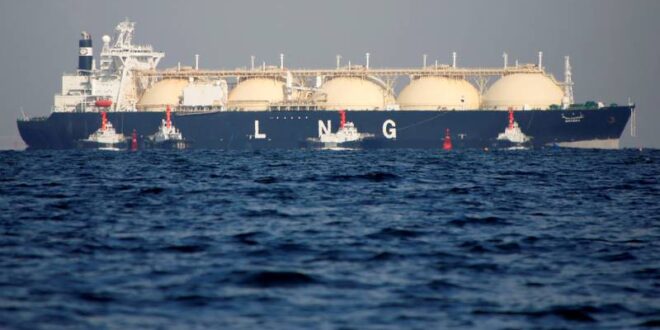Japan’s inventories of liquefied natural gas has surged since Russia’s invasion of Ukraine, government data showed, in an effort to address concerns over potential disruptions of the biggest portion of fuel for power generation in the country.
LNG inventories in Japan stood at 5.9 million tons as of the end of August, up 17.6 percent from a year earlier and the largest since comparable data became available in 2008, according to the most recent data from the Japan Organization for Metals and Energy Security, a government agency.
Nine major Japanese utilities ramped up their combined LNG stockpiles 56 percent from a year earlier to 2.63 million tons as of Feb. 19. The volume is above their average stockpiles in the previous five years, according to data from the Natural Resources and Energy Agency.
Concerns over LNG supplies increased after Russia reduced supplies to the European Union, prompting LNG importing countries to scramble to look for other suppliers and intensifying global competition.
Another reason for the increase in LNG inventories is the possible disruption of gas supplies from the Sakhalin 2 project in the Russian Far East. Japan buys about 9 percent of its overall LNG imports from the project, which is led by Russia.
“There is a risk that (Russia) may demand terms and conditions that are unacceptable” for Japan, Reiko Nakamura, head of the fuel operation division at Jera Co., said in a recent interview with Kyodo News.
Jera, a joint venture between Tokyo Electric Power Company Holdings Inc. and Chubu Electric Power Co., buys gas from Sakhalin 2.
British oil major Shell plc pulled out of the project in response to Russia’s invasion of Ukraine.
Resource-poor Japan depends heavily on fossil-fuel imports to meet its energy needs, with LNG accounting for about 35.5 percent of the total energy mix, the largest portion in fiscal 2021, according to data from the Natural Resources and Energy Agency.
Natural gas produces about 50 percent less carbon dioxide emissions than coal and 20 to 30 percent less than oil and is seen as a preferred option for reducing greenhouse gas emissions.
Nuclear power generation emits no CO2 but many reactors remain idle in Japan, subject to government screening of stricter safety measures introduced after the Fukushima nuclear disaster.
Japan holds over 200 days’ worth of oil reserves in stockpiles but there are only a few weeks of LNG inventories. LNG is not suitable for long-term storage due to the high costs involved and the speed at which it evaporates.
“Since there is no national reserve for LNG unlike oil and liquefied petroleum gas, it is necessary for the country to deal with risks that businesses cannot handle,” Nakamura said.
In a bid to reduce geopolitical risks to a stable energy supply, Japan is also stepping up diversifying LNG procurement.
Oman LNG, for example, signed a long-term LNG supply contract with Mitsui & Co., Itochu Corp. and Jera in December with shipments expected to start in 2025 or later.
Japanese oil and gas explorer Inpex Corp. also recently signed a 20-year agreement with Venture Global LNG to purchase 1 million tons per annum of LNG from the United States, one of the world’s leading LNG exporters.

 Iran Energy News Oil, Gas, Petrochemical and Energy Field Specialized Channel
Iran Energy News Oil, Gas, Petrochemical and Energy Field Specialized Channel



